We’ve hinted about adding honeybees to Curbstone Valley this year, and in fact, we’ve already ordered our bees which are expected to arrive in early April.
In the meantime though, we’re not devoid of bees. In addition to our native resident bumble bees, sweat bees, and feral honeybees, we also have Orchard Mason Bees (Osmia lignaria).
More than 400 species of Mason Bees are native to North America. Unlike honeybees they do not reside in communal hives with a queen. Mason Bees are solitary bees, and do not produce honey.
We may have already had some Mason Bees here, they can be difficult to spot, as they tend to resemble large flies rather than the traditional honeybees we’re used to seeing. To be sure we had some Mason Bees here though, last spring we purchased a Mason Bee habitat, and some dormant bees, and installed them under the roof of our workshop, facing south toward the orchard. Why though, if they don’t produce honey, would we want Mason Bees on the farm? For pollination of course!
There are a few advantages to having Mason Bees. The first is that beyond specific habitat requirements, Mason Bees need no direct care. They need food resources, access to damp soil, and a place for brood (the next generation of bees). That’s it.
Mason Bees, as they have no hive or honey reserves to protect or defend, don’t sting. They’re very placid bees to have in the garden, and aren’t bothered in the least by gardeners. They are capable of stinging, but they really have no incentive to do so.
In addition to requiring minimal care, and having placid dispositions, Mason Bees are efficient pollinators. Toward the end of a normal winter here, as the weather begins to warm, Mason Bees begin to emerge, sometimes well in advance of honeybees in the late winter, usually as the first blossoms on our fruit trees in the orchard begin to bloom.
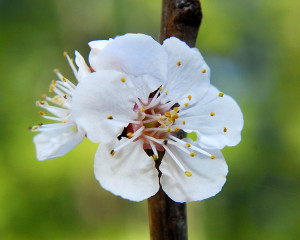
Our Flavor Delight aprium is just starting to bloom, and the Mason Bees should begin to emerge very soon
The male Mason Bees usually hatch first, for reasons that will become clear in a moment. The males only live for approximately a month after hatching, as their sole purpose is to mate with the emerging females as they hatch. The females however, with much work to do, live for approximately three months.
Once they hatch, and are mated, the females seek out suitable nesting sites, often the same sites from which they themselves hatched. They lay eggs in small tunnels in wood (or in artificial habitats like ours). Eggs destined to be females are laid first, toward the rear of the tunnel. Each egg is left with food in the form of pollen and nectar, and then each egg is sealed behind a thin ‘wall’ of mud. Forward of the wall, the next egg is laid, food is deposited, and another wall is built. The construction of these mud walls within the nests is how these bees acquired the name ‘Mason’ bees.
Eggs destined to be males are deposited closer to the tunnel entrance, and these will hatch before the eggs containing the females, which were laid in the back of the tunnels.
Once a tunnel is filled, the female will find another adjacent tunnel, or nearby nesting site, and begin the process again. Laying eggs, adding food, and building walls, throughout the spring. During this activity she will make numerous foraging flights for food.

To install the cocooned bees in their habitat, we simply replaced two of the nesting tubes with the tubes containing the bees (arrows)
Honeybees gather pollen and return most of it to the hive where it is stored and used as food for other hive members. Mason Bees don’t use a hive, so the pollen they gather stays with them, except for the small amounts deposited with their eggs as food for future young.
Mason Bees are rather hirsute, fuzzy little creatures, and not the most hygienic of bees.
It’s not unusual to see a Mason Bee almost completely coated in pollen.
As they travel from flower to flower, the pollen sticks to their hairs and is dragged around with them, and thus their slovenly pollen-coated selves result in a relatively high pollination efficiency.
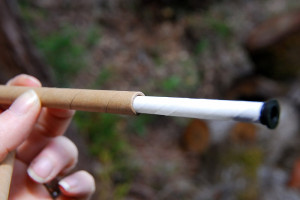
Each cardboard nesting tube in our bee habitat has a paper liner. The liners and/or tubes can be replaced as they become soiled.
On a per bee basis, Mason Bees are reportedly more than 100 times more efficient than their honeybee or bumble bee cousins. That however is somewhat misleading in regards to overall pollination, as without a hive structure, the number of Mason Bees in a particular location is significantly less than honeybees.
By mid-summer our Mason Bees are usually gone for the season. During this time, and over the course of the ensuing 9 months, the eggs laid in the nests mature. Mason Bees pupate in the same cell where the egg was deposited, consuming the food left for them, and the following early spring they emerge from their habitats as mature adult bees, and the cycle begins again.
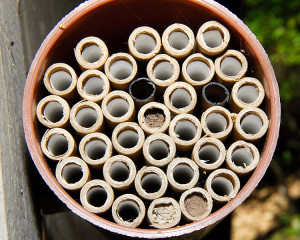
Our bees are still snug in their tubes. You can see that last summer the female bees laid eggs in at least three of the tubes, whose ends are visibly sealed with mud
Last year we were so busy getting the gardens fenced, trees planted, and raising chicks, that managing honeybee hives seemed rather daunting. After taking a class at a local nursery though, Mason Bees seemed to fit the bill perfectly, as at the time most of what was blooming in the garden were the fruit trees in the orchard.
If you’re interested in adding Mason Bees to your own garden, or simply want to add a Mason Bee habitat to encourage your native Mason Bees to nest in your garden, a number of online resources carry Mason Bee supplies, and some local garden nurseries sell cocooned bees and supplies in the late winter to early spring.
If you choose to construct your own wooden Mason Bee house, don’t use treated wood! For the nesting holes, studies have shown that Mason Bees prefer to nest in holes that are 5/16 of an inch in diameter, and between 3-5 inches in length. Holes that are too large will make the cocooned bees vulnerable to predation.
For ease of maintainance, wood block nests can be constructed to use the same cardboard tube liners as the commercially available nest we installed.
Needless to say with spring approaching there’s a lot of buzz around here at the moment. As our gardens are expanding, along with our planting plans, this spring we are augmenting our native pollinator reserves with two honeybee hives…but we’ll save the details of that for our next post!
—————-
If Orchard Mason Bees are not available locally, we’ve seen bees and bee habitats available through the following online sources:
High Country Gardens
Organic Control, Inc. (Orcon)
Peaceful Valley Farm & Garden Supply
Territorial Seed Company

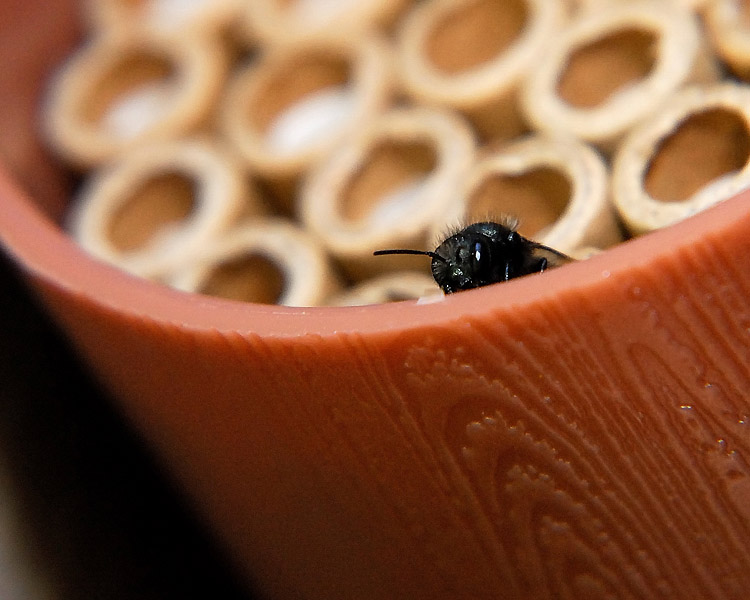
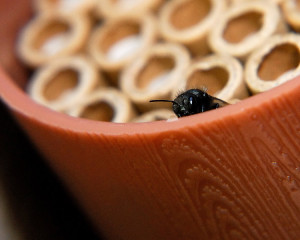

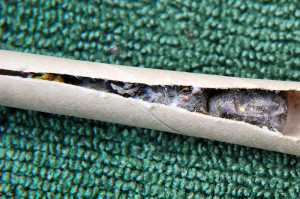
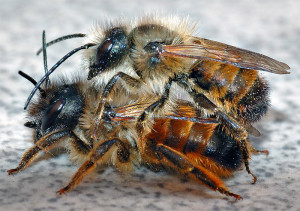
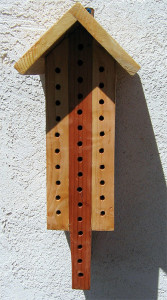


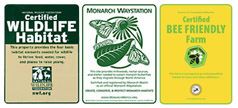




we’ve had two ‘hives’ of mason bees for the past five years – they will be very busy in our orchard once the temps warm up. we change the nesting tubes every spring once the bees have emerged.
That’s what I like about these artificial habitats, they’re easy to keep clean. The wooden blocks can trap disease, and re-drilling the holes to clean them can cause the holes to become too wide. I really would like to add another habitat in the orchard, now that we have more trees. Maybe if they do well this year I can split some of the tubes out into a new nest.
Always another nice post. Where do you think the mason bees go after mid summer? Another habitat or are they just plain kaput for the year?
Kaput. Like most bee species, Orchard Mason Bees are very short-lived. The females tend to live longer than the males, but most have died by early to mid-summer.
Very interesting. Most interesting is the fact that the female knows which eggs will be male. How curious. I like the idea of mason bees because they are easy keepers. Here at the university, one of our professors has honey bees in his backyard and has helped other faculty set up small hives. Quite tempting. As you, we are ordering our chicks in March, and I am sure that they will require plenty of attention. Perhaps next year bees. Thanks for the good article. cheers. ann
I should have mentioned how the females determine which egg is which. Before laying the egg, the female can choose whether or not to fertilize it. If she fertilizes the egg she is laying, it will be destined to be a female. Unfertilized eggs develop into males. Insects really are quite remarkable creatures!
Good luck with your upcoming chicks!
Awesome post once again! We have mason bees, carpenter bees (a bit more aggressive and a lot larger) and digger bees.
Where did you order your honey bees from? We’ve got our Langstroth hive now but I haven’t ordered bees yet.
Rachel, our local Beekeeper’s Guilds are both coordinating ordering bee packages for this spring. I expect the guilds closer to you are doing the same. Ours here (Santa Clara and Santa Cruz) are taking orders through early March, so if you want to order packages of bees (a Queen with 3lbs of bees) you probably need to do so soon. Of course, you could always try trapping some feral bees, or finding someone that hives swarms as an alternative source of bees.
Hi CV,
Congrats on getting some Bees, I do love having them buzz around and always look forward to hearing them for the first time in the Spring.
Thanks for the info. I have been thinking of getting some honey bees, but not sure I have the time to devote to them. I didn’t realize mason bees were good pollinators, what a great option.
I didn’t know very much about Mason Bees before we took our class last year. Now though, I’m so glad we have them!
Clare, I love these “rather hirsute, fuzzy little creatures” and thank you for telling us about them~I have been wanting to order tubes but, wasn’t sure I had enough garden to offer them! I added a small cutterbee house last summer. I love our native bees! gail
Gail, I can’t imagine these bees would starve in your garden! 😉 The biggest thing is to ensure that you have some early blooming nectar and pollen sources at the time the bees emerge, to encourage them not to wander too far in search of food. Our fruit trees fit that bill, but so does our trailing rosemary, which has been bloom for the last few weeks. I’m sure they’d find plenty to eat at your garden buffet!
Dear Clare, What a wonderfully informative posting! We provide a mason bee habitat, but I knew little about them until I read this. Providing for pollination should be high on every gardeners list. P x
I agree, pollination is so very important, and with so many honeybee hives not surviving the winters, even in our mild climate, as gardeners we need all the help we can get!
This was so interesting! I knew very little about Mason bees. This might be a fun project for our family to do, making the wooden bee house doesn’t seem too difficult. Thanks for such an informational post.
As garden projects go, I think building a Mason Bee house is a wonderfully easy project. I think it would ‘bee’ a fabulous family project, and very exciting to see when the bees move in!
A fascninating post Clare and am amazed your blossom is already out ready and waiting for them. My granddaughter templated a mason bee house for her A level design project – one that children could easily construct 🙂 We have Masons, Miners, and Carders – all solitary bees that our gardens cannot do without.
We’ve had some strangely warm weather in January and February, and the fruit trees have been starting to bloom a little too early…this morning I woke up to 29F! The poor orchard is very confused at the moment!
Fascinating – especially the description of how they lay their eggs in order and then wall them in. They sound ideal for people who are interested in bees but wouldn’t want to manage a hive. I enjoyed your post very much.
I agree, I think Mason Bees are a fun way to bring bees to the garden, teach children about bees, and feel as if you’re helping the area pollinators, but without a huge investment in time or equipment. 🙂
We visited an apple orchard in Utah last year that had the Mason Bee houses scattered around it. Or at least that is what they looked like.
I remember when I had bees I ordered mine mail order. My little rural Ky post office give me a call when they showed up. Seems I wasn’t the first one in town to order bees either! Honeybees are fascinating creatures.
I remember when you could get bees mail-order, but I’m not seeing many apiaries doing that these days. It is funny to think of all the things the post office has to handle…our peeping day old chicks came in the mail, and the post office seemed very nonplussed, like it happens everyday!
My plan was to add honeybees this year also, but my husband wants to build the hive and I’m not sure if it will be completed in time for this season. After reading your post, I know I’ll definitely be adding Mason Bees to my garden! Thanks for sharing the info!
We considered building our own hives too, although we have enough projects to keep us busy for a long time! 😛 However, now is great time to get Mason Bees, and at least you’ll have some extra pollinators in the garden until your hives are finished!
I think I might have these in my garden. We have so many different bees, and I cannot identify any of them, unless they have a brilliant color, like the sweat bees. Anyway, I do have some that lack pollen pockets and absolutely drown themselves in pollen. I find them often in the wildflower garden.
Well FG, that sounds like a great project for your new camera! 😉 I’ve been able to identify some of the species of native bees here. I start by taking as many photos as I can, with relative high shutter speeds so they don’t just blur across the lens. Then you can enlarge the images, and look at them critically to help you identify which bees are frequenting your garden (and get a blog post or two out of the effort too) 😀
Bees are so fascinating, and I keep learning new things about them. I’m kind of curious: If they nest in holes in trees no one puts paper tubes in those holes, why the extra paper (or cleaning etc) with the bee houses? So far, I’ve just told myself nature knows best and left my bee house along, but maybe I need to get to work!
Nature does know best, but when we provide bee habitats, they’re not really natural homes. In the wild Mason Bees nests are probably more spread out. More bees in a concentrated area can concentrate pests and disease. Just as is true with bird feeders.
Many who use wooden block Mason Bee houses don’t use the paper liners. I think the reason for using the paper liners is primarily to help increase survival of the bees. Wood absorbs moisture, and retains pathogens, both of which can lead to decreased survival. Some Mason Bee homes can get quite clogged with debris over time, and without cleaning out the holes, they get plugged, and the bees won’t continue to use them. They’ll just move on. Drilling out the blocks to clean them tends to make the holes too large, and again, the bees won’t use them. A clean dry home, with the right size tunnels, encourages them to return year after year, and helps to ensure that more bees survive the many months they are entombed behind their mud walls.
Dear Clare, I do think that we must do everything we can to boost bee populations of whatever kind since they seem to be diminishing on a massive scale. Certainly in London I am very aware of much reduced bee numbers over the years. Honeybees and your own honey….ambrosia indeed!!
I knew you could buy or make the habitat, but I wasn’t aware you could buy the dormant bees. Interesting how the bees lay the female eggs in the back and the males in front. I wonder if the mother bee knows what the eggs will turn out to be or what she feeds them affects the future gender. Also what happens if the male 3 cells back hatches before the first 2?
Just saying a quick “hi” and wondering what you’ve been dreaming up over the winter. Now I know! Very cool. (and very different!!)